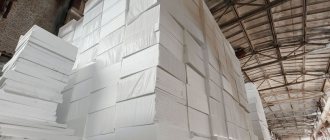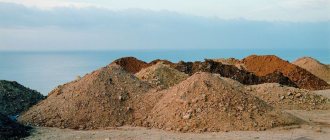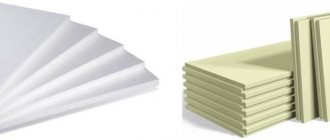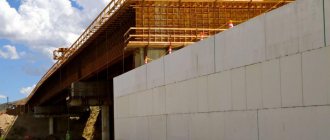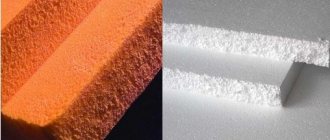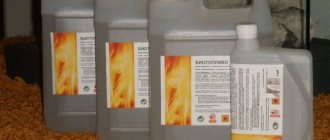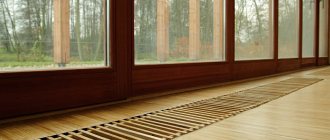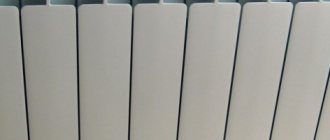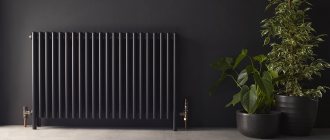Expanded polystyrene (polystyrene) is very harmful to the environment and cannot be recycled in most places. Therefore, reuse is a great way that not only does not harm the environment, but will also benefit you.
But how can you reuse foam to make useful things? This article will answer a question that interests many.
Since I had some foam left after insulating the house, I decided to use it for domestic purposes. Here are the best ways to reuse polystyrene foam, including instructions or details for each item on the list.
Main characteristics
- thermal conductivity is low (the extruder has the same thermal conductivity as other types of polystyrene foam, but the extruder is more expensive)
- durability (up to 60 years does not lose properties when the temperature changes from -40 to +40 °C throughout the year)
- moisture resistance
- it does not create an environment favorable for the development of mold and similar “life” (can only occur on the joint surface of, for example, wood)
- minimal harmfulness (it is allowed to be used in the food industry (packaging));
- a light weight
- noise insulation (3 cm thickness reduces noise up to 25 dB)
- fire resistance (we can only talk about it when it comes to fire-resistant varieties; you also need to know that in the production of fire-resistant types, a larger amount of carbon dioxide is used and if the combustion process takes place directly, then the release of this gas will be greater and it will burn, although the temperature it has a high temperature of +490 °C)
- vapor permeability (similar to wood such as oak)
- tensile strength is at least 20 MPa
- resistance to alcohols and ethers, but is easily destroyed when exposed to solvents
- does not withstand ultraviolet radiation (when using slabs, they must be covered with a protective layer of primer and painted)
Expanded polystyrene is mistakenly called polystyrene foam in everyday life. Let's look at the main differences between the characteristics:
- absorbs water and vapor
- visually they can be distinguished (it has a uniform structure, and the foam has large granules)
- density higher than foam
- mechanical strength
Flat crafts
Making flat products is more common for beginners of this interesting activity. For products of this kind, ceiling tiles and thin pieces of foam packaging from household appliances are more suitable.
To work, you just need to decide what exactly the master wants to depict. It could be a photo frame, a house, a bird, some kind of plant, fish.
After selecting the desired picture and material for its manufacture, draw a sketch, transfer it to a piece of foam plastic and cut it out with a sharp knife.
The final maneuver - painting the craft and covering it with varnish - is not difficult.
We recommend reading:
DIY crafts from Kinder surprise eggs - 125 photos of exclusive options with step-by-step instructions, master class and videoCrafts made from twine - an overview of original design solutions. More than 100 photos of new products + step-by-step instructions for creating crafts with your own hands
DIY crafts from candy wrappers: 150 photos of the best ideas from craftswomen. Simple instructions, master class, diagrams and video tutorials on creating crafts from candy wrappers
Advantages
If all installation rules are followed, liquid foam will last more than 50 years without defects. Other arguments in favor of insulation such as Liquid Penoplast:
- Fire safety;
- adhesion (bonds, connection) with solid materials (concrete, stone);
- natural composition, safe for human health;
- fire resistance;
- reasonable price;
- wide range of permissible temperatures;
- static dimensions, no swelling after hardening;
- low consumption over large areas;
- minimizing the risk of surface damage by microorganisms or insects.
The material does not require preliminary thorough preparation of the surface, which significantly reduces time and money costs. To apply foam with your own hands, you will need a hose (diameter of at least 30 mm). With its help, the substance reaches the most inaccessible places. Insulation using the “old-fashioned” method (using foam rubber) has long since sunk into oblivion due to its ineffectiveness.
Interesting fact: the quality indicators of vapor permeability make it possible to successfully use liquid foam to protect wood coverings, walls, and facades.
Do-it-yourself material recycling
If you want to know exactly how you can recycle polystyrene foam, we suggest you consider the step-by-step instructions. All you need is enough foam and a crusher. Then you can get polystyrene foam granules and use them for your own purposes. If you don’t have your own foam crusher, you can make one yourself. After all, factory models have a very high price.
Here's what you'll need to have a new useful tool on your farm:
- sewer PVC pipe, diameter 50 mm;
- tape measure and marker;
- metal file;
- a wooden beam that would fit inside the pipe;
- metal screws;
- screwdriver and drill;
- metal studs with bolts;
- Chipboard or plywood to create a box.
Using this set of tools and materials, you can create a working foam crusher. With its help, sheets or other foam crafts will turn into crumbs. The mechanism is based on a moving part with teeth, which crush the foam into granules. And thanks to the container or box, it is easier to direct the material to the rotating mechanism. You will learn exactly how to create a crusher in this video.
So, when the crusher is ready, you can start working. Here's what to do:
- Choose a suitable location. Alternatively, choose a garage, warehouse, storage room or shed.
- Install the crusher, taking care of the container underneath it, where the crumbs will fall. This could be a bucket, bag or wooden box.
- Foam sheets are easy to crush. But as for figured products, it is better to break them into pieces with your hands in advance.
- Now all that remains is to turn on our homemade unit and gradually process the raw materials.
Thanks to this technology, most of the granules will remain intact. This means that they will cope with their task better than ever. You just need to be careful, as the foam is electrified and very light. It is important to make sure that there are no drafts in the room, otherwise you will have to remove everything from the floor later. Now the foam can be collected in bags and used immediately or stored until it has its time.
Note! If you melt the foam with acetone, it can be used in liquid form as glue. Although the mixture cannot be called safe.
Characteristics and properties
Expanded polystyrene is designed to retain heat. This happens due to compressed small balls containing air. They form a solid air cushion, similar to foam, which is why the material has a similar name.
The density of the material ranges from 0.028 to 0.034 watt meter per Kelvin. The indicator depends on weather conditions. Scientists proved in 2014 that mold fungi are not able to live on this insulation.
Each type has its own vapor conductivity. For example, extruded does not allow steam to pass through at all, but foamed - from 0.019 to 0.015 kg per m/h/Pascal. The difference appears due to the fact that the second type is obtained by cutting from a whole block into slabs of the required thickness. Therefore, air penetrates through the broken structure of the balls.
Moisture absorption works on the same principle as vapor barrier. Solid polystyrene foam will absorb a maximum of 0.4 percent of water, thinner ones can absorb ten times more - 4%. Due to its dense structure, extruded is considered strong, approximately 0.4 to 1 kg per square cm.
Due to the presence of antiperspirants in the composition, polystyrene foam will last for many years without losing its advantages. Based on all of the listed properties, solid polystyrene foam is significantly better than foamed polystyrene. He almost ousted his competitor from the market and became the most popular.
Types of waste and delivery requirements
Accumulated waste must be sent for recycling. This helps to get rid of garbage and receive monetary compensation.
If you want to hand over PPP for recycling, it is important to know what kind of waste the collection points accept. Requirements for accepted recyclable materials are also important.
The main conditions for receiving polystyrene foam are cleanliness and non-melting (not subjected to thermal influence). Polymers containing fuel and lubricant residues, paint, tape, labels, and various technical fluids are not accepted. Recycling dirty polymer waste is problematic.
The minimum weight of raw materials must be at least 1 kg.
The price of polystyrene foam depends on the type:
- dishes;
- equipment packaging material;
- residues from dismantling houses, ships, carriages, refrigeration equipment;
- food packaging;
- polymer production residues.
Before sending to the receiving point, it is better to collect a large batch of raw materials. This will increase the cost per 1 kg. The greater the weight of recyclable materials, the higher the price.
The price per kg, depending on the type of waste, the specific region, type, and condition of the foam, is 5-20 rubles. The price for polystyrene foam waste may vary depending on the location of the points.
What is polystyrene foam or expanded polystyrene?
First you need to understand what polystyrene foam is and how it behaves under various influences. And understand whether polystyrene foam is harmful to health?
Expanded polystyrene is a gas-filled material. They are made by steam heating polystyrene granules. These granules are first filled with gas. The gas used is different: in ordinary polystyrene foam, natural gas is used, in fire-resistant foam, carbon dioxide is used. When heated, the gas expands, and the granules increase many times in size (15 - 30 times the original).
If nothing restrains the expansion of granules, then the result is a crumbly material that is used in filling frameless furniture, packaging, and construction. To obtain solid forms of polystyrene foam, foaming is carried out in a closed form of the desired configuration. This is how flat sheets of insulation, embossed decorative products, boxes for packaging household appliances and much more are obtained.
The resulting material has a number of very advantageous qualities:
- high thermal insulation;
- high durability;
- low water absorption;
- low vapor absorption;
- biological stability;
- unattractive to rodents and parasites.
Polyfoam is an inexpensive, very light, practically non-moisture-absorbing material with low thermal conductivity. It is resistant to rot and biocontamination, durable, can take any shape and be elastic, but hard enough to hold its shape.
Thanks to this, expanded polystyrene has become widely used in many areas:
- In ammunition for safety (both military and civilian). In helmets, knee pads, and elbow pads, polystyrene foam is used as a shock-absorbing material and insulation.
- For the production of disposable tableware. Containers for hot food and cups for drinks are widely used.
- As packaging material. Expanded polystyrene protects fragile items well during transportation. It can be used both in bulk and in the form of pressed forms of the desired profile.
- For the manufacture of children's toys and child safety products.
- For frameless furniture (poufs, bean bag chairs).
- When making blanks for handicrafts and creativity.
- For the manufacture of decorative elements of the interior and garden decoration (fake stones, garden figures)
- In some countries (Japan, Finland, Norway, Canada, USA), polystyrene foam is used in road work to protect soil from freezing, reduce the vertical load on soils prone to subsidence, create artificial unevenness, etc. In Russia, polystyrene foam is not used for this purpose .
- For interior and exterior finishing. Various decorative elements of facades, ceiling tiles, imitation stucco molding and much more are made from expanded polystyrene.
- In the production of polystyrene foam, concrete and polystyrene foam blocks for the construction of walls in low-rise construction.
- For the manufacture of various heat-insulating and sound-insulating materials.
We advise you to study - Classification and types of bits for a screwdriver
Polystyrene foam packaging
Structure and composition of foam
Polystyrene foam is a special type of material that is foamed plastic.
This is a white material. Its structure consists of 98% air and 2% polystyrene.
It is prepared using a special technology, which includes foaming polystyrene granules. At the next stage, the resulting granules are doused with hot steam. These stages are repeated several times, resulting in a porous, lightweight material. The resulting mass is dried. Granules of 5-15 mm are formed.
The granules are pressed on a special machine into the required slab size and doused with hot steam for finishing.
As a result, slabs are formed consisting of a billion balls, very light and at the same time strong.
The influence of polystyrene foam on human health
Questions about whether polystyrene foam is harmful to health or not have worried consumers almost from the very beginning of its use. Each new finishing and building material based on foam plastic caused a renewal of these disputes.
Proponents of the use of expanded polystyrene cite the research of scientists - chemists, physicists and materials scientists - as a safety argument. Expanded polystyrene, without external influences on it, practically does not interact with the environment.
Its molecular structure is very stable. The experiments described above show that under normal human conditions, polystyrene foam does not emit any harmful substances. Actually, it does not release any substances.
Might be interesting
Opponents of the use of expanded polystyrene claim the possibility of styrene release. Even if not under ordinary, but under extreme conditions. Extreme conditions refer to exposure to high temperatures. Indeed, when burned, polystyrene foam, like many other substances, releases a large amount of toxic substances, among which styrene is considered especially toxic.
Effect of styrene on humans:
- dizziness;
- irritation of the mucous membranes of the eyes;
- high concentrations lead to lung damage and even fatal poisoning;
- the functioning of the kidneys, liver, and hematopoietic system is disrupted;
- oncology.
The flammability of the initially created polystyrene foam was quite high. At temperatures above 210 °C, the foam was able to independently support surface combustion and spread fire. That is why fire retardants (substances that inhibit ignition and flame spread) are now used for the production of construction and finishing polystyrene foam.
Thanks to this, it was possible to reduce flammability and increase the ignition temperature to 440 °C. In addition, most modern polystyrene foam products do not allow flames to spread and do not support spontaneous combustion.
It must be said that, like many other substances that are dangerous in large doses, but harmless in small doses, styrene is naturally found in many products that we use every day - coffee, tea, cinnamon, cheese, strawberries and so on.
Melting polystyrene foam
The harm of expanded polystyrene to human health may also be associated not so much with the qualities of the material, but with its improper use in finishing. Expanded polystyrene is a very popular thermal insulator, but at the same time it does not allow steam and moisture to pass through. It happens that people, out of ignorance or out of economy, insulate the walls between the apartment and the street from the inside with sheets of expanded polystyrene.
This situation is serious because the moisture in the warm home air collides with the cold wall directly under the foam and condenses there. The wall on the concrete surface is constantly wet, which will inevitably lead to the development of fungus and black mold, the spores of which are a dangerous allergen. Black mold can trigger the development of asthma, chronic bronchitis and other diseases.
Thermal insulation of engineering systems
Foam plastic has become very often used for thermal insulation of engineering systems. For example, for thermal insulation of water and sewer pipes during winter freezing, the use of polystyrene foam will be simply irreplaceable, as it will help to avoid the catastrophe of pipe breakage in the winter. Foam plastic is also used for thermal insulation of cold water supply pipes. Ventilation ducts, telephone lines and recessed ducts are also insulated with foam.
If you notice an error, a non-working video or link, please select a piece of text and press Ctrl+Enter .
0
What to choose for the balcony: polystyrene foam or other materials?
- Styrofoam. The most popular material for insulating loggias and balconies. It differs from others in its availability, good technical characteristics and low cost. Also, it is easy to install.
- Penofol. It is often used as a vapor and waterproofing material and a base for thermal insulation. It is a layer of foamed polyethylene, which is covered with foil on one or both sides. It is lightweight and thin, and is available in rolls.
- Extruded polystyrene foam (Penoplex). It is an orange-colored slab that has a low thermal conductivity coefficient and a long service life (up to 40 years). Tolerates high humidity well. It has higher strength and cost compared to other materials.
- Mineral wool. It is as widespread as polystyrene foam. It has good technical characteristics, is resistant to fire and is of natural origin. However, when insulating a balcony and other building elements, it requires high-quality vapor and waterproofing.
If you need high-quality insulation of a loggia or balcony, and there are no plans to spend large sums of money, then using polystyrene foam is the best option.
How harmful is polystyrene foam for house structures?
How does insulating a private house with polystyrene foam affect the strength and durability of other materials used in structures? There is still some negative impact. It occurs due to the low vapor permeability of foam. With insufficient ventilation and an incorrect insulation scheme, excess moisture may form at the junction of this and other vapor-permeable materials. Hence the appearance of fungus and mold.
The material itself is not subject to destruction from such influences, but colonies of pests can grow quickly. Having moved onto wood, for example, they will very quickly destroy it. Especially if the tree has not been protected from biological influences .
External insulation of an aerated concrete house with polystyrene foam can have a bad effect on the internal state of the microclimate. If the blocks were not dried before insulation, moisture will remain inside throughout the entire operation of the house. It will also contribute to the development of harmful fungi and mold, which adversely affect the health of residents.
Types of foam
Divided into the following types:
- polystyrene;
- polyethylene;
- polyvinyl chloride;
- polyurethane.
Polystyrene
There are two ways to produce this type of foam:
Pressless. This variety is familiar to every person
When buying home appliances, you can pay attention to the fact that they are packaged in foam plastic, consisting of small balls fastened together. It is very fragile and can be crushed and broken by hand.
Press
But this type will be much more difficult to crumble. The granules of such foam are more tightly bonded to each other. The production technology is much more complex and more expensive than that of the non-press type, so it is much less common.
There is such a variety as extruded foam; it is practically no different from non-pressed foam.
Polystyrene types of foam have one significant disadvantage - high hygroscopicity.
Water vapor enters the cavities that are located between the “balls” and granules.
We advise you to study - Interior of a children's room for a boy - colorful and bright ideas
This material “does not breathe”, so the steam does not escape anywhere and when exposed to sub-zero temperatures it can freeze, destroying the structure.
Even in the absence of exposure to cold, the accumulated steam worsens the thermal insulation properties of the foam and increases the humidity in the room.
Extruded foam plastic does not have such disadvantages, since it is homogeneous in its structure. It is common in the production of disposable cutlery, tableware, and food packaging.
As for the durability of polystyrene foam, we can say that for non-pressed foam it will range from 10 to 35 years. Extrusion will last much longer, about 50-70 years. Of course, the service life directly depends on the manufacturer of the material and the impact of destructive factors at the installation site.
Polyurethane
One example of polyurethane foam is foam rubber. It has a porous structure, good air and steam permeability, and high elasticity. It is used in furniture production, both as upholstery and as a filler.
Based on it, many household items are made. It is highly flammable and releases hazardous substances that are more toxic than polystyrene foams. The reason for this is hydrocyanic acid in the composition. It is extremely short-lived, turns yellow and is destroyed when exposed to external factors such as ultraviolet radiation.
Polyvinyl chloride
Polyvinyl chloride itself is a thermoplastic polymer that contains up to 56.8% bound chlorine, which makes it difficult to burn. It can be produced using both press and non-press methods. Its properties are similar to extruded polyethylene foam.
It contains no toxic substances. When burning, polyvinyl chloride foam extinguishes on its own.
It is highly elastic, but can corrode metal structures next to which it is located.
Polyethylene
It occurs quite often in everyday life. It looks like a translucent film consisting of air pimples.
It is used for wrapping fragile items and easily damaged equipment and does an excellent job of protecting against damage.
Polyethylene foam is very elastic and has different thicknesses, from a few millimeters to several centimeters. It is similar in strength to extruded polystyrene foam, but its distinctive feature is its non-toxicity. It is considered an environmentally friendly material with a long service life. Flammable.
Extruded polystyrene foam
Extruded polystyrene foam (XPS, EPS, extruded polystyrene foam) consists of the same substance as polystyrene. Their difference lies in the technology of granule formation itself.
Conventional polystyrene foam is made by “steaming” microscopic granules with hot water steam. As a result, under the influence of hot steam, the granules begin to greatly increase in size until the production mold is filled.
In turn, the production of extruded polystyrene foam is carried out using the so-called extrusion method. In this case, microgranules are mixed with a foaming agent at high temperature and pressure. The resulting mixture is then squeezed out of the extruder.
Thermal conductivity table of the most commonly used building materials
For comparison, here are some properties:
- thermal conductivity – low, 0.029-0.034 W/(m·C);
- water absorption – low, 0.2-0.3%;
- vapor permeability – extremely low, 0.013 Mg/(m h Pa);
- specific gravity – low, 25-45 kg/m³.
When it comes to thermal conductivity, regular polystyrene foam is inferior to EPS because it has an average thermal conductivity of 0.038 W/(m C).
One of the serious disadvantages of extruded polystyrene foam is considered to be extremely low vapor permeability, which is 5 times lower than that of conventional polystyrene foam. This drawback imposes additional requirements on the ventilation system of the insulated object.
In addition, extruded polystyrene foam belongs to class G3-G4 - materials with high flammability. While some types of ordinary polystyrene foam can be slightly flammable.
Thus, extruded polystyrene foam is a polystyrene foam that differs from ordinary polystyrene foam in its production technology.
Advantages and disadvantages
Now it’s worth considering what the advantages of one and the other materials are. After all, each of them was invented for a reason and is in demand among consumers.
Styrofoam
The main positive qualities of polystyrene foam include:
- Using it as wall insulation both inside and outside the building.
- Its relatively low price is why it is in demand among consumers.
- The material is quite moisture resistant.
- Has little weight.
- Easy to use and install. In addition, it is easy to cut using a knife or other cutting object.
- Good insulation for foundations.
- Polystyrene foam can be cut at various angles, and any shapes can be cut out of it.
- The material can be painted and plastered.
Polystyrene foam is a good insulation material for foundations.
The disadvantages of the material include:
- The thickness of the material used should not exceed 3 cm.
- To better attach the material to the wall, it must be perforated, for example, with a needle roller.
- It is necessary to take care of the fireproof coating for the material.
- When installing foam sheets, it must be completely coated with glue.
- When leveling the sheet, it is necessary to use a moisture-proof putty.
It can be seen that the material has both positive and negative sides. Therefore, before purchasing, you need to weigh the pros and cons so as not to get into trouble.
Expanded polystyrene
Its main advantages are:
- It does not transmit heat well, meaning it remains indoors.
- It does not allow moisture to pass through well, which means that even if the material is exposed to rain for several hours, it will remain dry.
- Despite its artificial origin, it allows the house or any other structure to breathe.
- Not subject to rotting.
- Not affected by fungus.
- Durable. Can last about 50 years.
- The material is good to use as a sound insulator. Because it has a homogeneous structure that muffles and absorbs sounds.
The disadvantages of this material include:
- Price. This material is not the cheapest. This is why many consumers buy polystyrene foam.
- This material is destroyed under the influence of certain solvents.
- Expanded polystyrene is susceptible to destruction by rodents. It is quite easy for them to build passages and houses in the material.
- Just like polystyrene foam, polystyrene foam is a flammable material. Therefore, it is necessary to take care of safety. Cover it with a special solution.
It can be seen that the positive aspects of expanded polystyrene are quite attractive, in some cases even better than those of polystyrene foam. However, the main and sometimes decisive disadvantage is the high price of the material.
Chemical and biological resistance
Solutions of salts, acids, alkalis, sea brines, cement, bitumen, water-soluble paints do not have any effect on the foam.
Organic compounds, solvents, gasoline, oils, acetone, kerosene, etc. “kill” the foam. Because the cellular structure is destroyed and the material can completely dissolve.
Ease of installation. Lightweight slabs are simply cut. They are easy to work with and installation is not difficult.
Fire safety. Polystyrene foam catches fire from direct contact with fire. If the source is removed, self-extinguishing occurs in 4 seconds. This characterizes it as a fireproof material.
Styrofoam brands. The brand of polystyrene foam is determined by its density and is indicated by a set of letters and numbers, while the higher the number, the denser the material. The grade of polystyrene foam determines its use.
How do foam products affect the environment?
Of course, such a proliferation of material and its daily participation in human life makes one wonder: is polystyrene foam harmful or safe?
Manufacturers declare that one of the most important performance qualities that polystyrene foam possesses is environmental friendliness. But their interest is quite understandable. That is why, when determining whether polystyrene foam actually harms the environment, it is better to turn to scientific research.
Expanded polystyrene under a microscope
The environmental friendliness of any material is determined by its own impact on the environment, the impact under certain conditions and when interacting with other substances.
Moreover, it is necessary to consider both the immediate impact and the long-term one. Here are the main influencing factors:
- Expanded polystyrene practically does not absorb water and does not interact with it at all. Therefore, its use, for example, in finishing and insulating facades, is not only effective, but also safe. It follows from this that ceiling tiles made of foam plastic, if not heated, pose no harm.
- Expanded polystyrene does not oxidize when exposed to air and does not decompose when exposed to ultraviolet radiation. These qualities allow polystyrene foam to be disposed of in a household waste dump, rather than at a specialized chemical site.
- Expanded polystyrene is not dissolved by any substances that it might come into contact with in a household waste dump. Solvents for it are acetone, original styrene, aromatic and chlorinated hydrocarbons. These substances are not (or at least should not be) found in household waste dumps.
- Expanded polystyrene is a very durable material. Cyclic stability tests with annual temperature changes in the range from -40 ° C to +40 ° C with exposure of the material to ultraviolet radiation and water showed that even after 80 cycles (which corresponds to 80 years), the structure of polystyrene foam remained unchanged.
- Temperature extremes are not typical for polystyrene foam use conditions, but have also been studied. When heated without an open flame source, even polystyrene foam not treated with fire-fighting substances begins to collapse only at 300 °C, and with an open flame - at 210 °C. The impact of low temperatures can not be taken into account at all, since destruction occurs only superficially, and even then at -310 °C.
We advise you to study - Which substrate to choose for laminate - manufacturers' recommendations
Unfortunately, the bulk of used polystyrene foam is disposed of in household waste landfills. When buried, polystyrene foam is practically harmless to the environment, since it does not interact with water and air, but it does not decompose.
The situation is complicated by the fact that the collection and processing of polystyrene foam is not economically profitable today. During processing, expanded polystyrene can be used to produce polystyrene, however, the cost of this process is comparable to the production of polystyrene from primary raw materials, but requires a more complex organization of the process.
Another way to process expanded polystyrene is to grind it for use in the production of concrete - expanded polystyrene blocks, filler for heat-insulating mixtures and similar materials. This is a promising area of recycling that offers hope for reducing landfills.
Pile of old foam plastic
It is too early to say what harm polystyrene actually causes or will cause to the environment. The material is very durable. Even the first mass-produced foam plastics, buried in landfills long ago, have not yet approached the threshold of decomposition.
Safety measures in the production of polystyrene foam
The production of expanded polystyrene is a fire and explosion hazardous industry and requires certain safety measures. Pentane, which is actively released during pre-foaming and curing of polystyrene in silos, is heavier than air and accumulates at the floor level of production premises. Therefore, it is necessary to provide intrinsically safe equipment and pipelines, as well as sensors that monitor safe levels of pentane.
Places where pentane accumulates are raw materials warehouses, storage facilities and finished product storage areas.
So, security measures:
- It is necessary to provide at least 2 escape routes.
- Storage areas for pellets and finished products should be separated by fire walls.
- The optimal temperature in the silo is 24 ᵒC.
- The volume of the silo should be 2-2.5 times greater than the daily production rate.
- Store the material at a temperature not lower than 20 ᵒC and a relative humidity of at least 70%.
- Walls and floors must be made of fire-resistant materials, and all processing equipment must be spark-proof.
- Passages – at least 1.2 m.
- Flame and smoke sensors and automatic fire extinguishing system.
There are cases where polystyrene foam production facilities burned down in 12 seconds. For this reason, the processing of expanded polystyrene is located in separate buildings
The use of foam plastic for thermal insulation
Wall insulation
Polystyrene foam is widely used as insulation for external walls, and even owners of city apartments have begun to do this in the face of significant increases in energy prices.
The polystyrene foam is screwed to the facade of the building with dowels, then plastered, after laying a metal mesh on top of it.
Another common option is:
- Polystyrene foam is laid in the spaces between the sheathing bars, the cross-section of which corresponds to the thickness of the slabs
- Siding panels are attached to the sheathing with seams sealed with foam
Polystyrene foam is also widely used as insulation for walls inside an apartment.
Insulation of basements and plinths
When insulating basements, foundations and plinths with foam plastic, the low strength of this heat insulator should be taken into account. In winter, it will experience significant loads from freezing soil, which, if unprotected, will lead to its deformation or destruction. For this reason, a brick or concrete lining is constructed outside the thermal insulation layer of foam plastic.
Floor insulation
The environmental friendliness of polystyrene foam has led to its widespread use inside buildings. For example, it is often used as a thermal insulator in floor construction. The polystyrene foam is laid on top of the waterproofing layer, filling the seams with polyurethane foam or silicone sealant. Then a screed and a finished floor covering are laid on top of the slabs.
Methods of roof insulation
Thermal insulation of roofs using foam plastic is carried out using one of two technologies:
- Installation of a non-ventilated (warm) roof. With this method, the roof is covered with 70 mm thick foam plastic slabs, which are then filled with bitumen
- Installation of a ventilated (cold) roof. In this case, the foam is attached to the inside of the roofing so that there is a ventilated gap through which water vapor will be removed
Is foam plastic harmful as insulation?
A significant disadvantage of polystyrene foam is the high danger it poses in the event of a fire. Manufacturers and marketers position this material as non-flammable and point to its ability to self-extinguish, which is especially evident in the presence of a fire retardant additive. However, a material does not have to ignite to be dangerous in a fire.
As experience and numerous tests have shown, exposure to flame and high temperatures provokes thermal decomposition processes in foam plastic, as a result of which the air, even at a considerable distance from the fire site, is filled with a large amount of smoke, corresponding in toxicity to substances of the highest hazard class.
There are a large number of insulation materials for the home. If foam is not your thing, then you may want to consider other options. For example, Rockwool insulation, the technical characteristics of which make it possible to perfectly protect the house from heat loss. The structure of the material allows the walls to “breathe”, therefore, there will be no problems with rotting and fungus formation.
Rockwool insulation is essentially mineral wool. If you only need to insulate the ceiling, we recommend that you familiarize yourself with the process of insulating the ceiling with mineral wool here. You can install this material yourself.
Price
Here is the approximate price for polystyrene foam as insulation of various brands:
- PSB-S-15O (density - about 9 kg/cubic m): 1050 rub.
- PSB-S-25 (about 15 kg/cubic m): 1800 rub.
- PSB-S-25T (about 20 kg/cubic m): 2350 rub.
- PSB-S-35 Light (density - from 21 to 23 kg/cubic m): 2550 rub.
- PSB-S-35T (density - from 26 to 28 kg/cubic m): 3050 rub.
Users unanimously recognize the affordable price as the most important advantage of polystyrene foam. Forum participants rate the thermal insulation qualities of polystyrene foam quite highly.
But owners of private houses advise using this insulation only where there are no problems with mice. One of the users said that in the polystyrene foam he used to insulate the garage, these rodents made a whole system of passages, and their activity is accompanied by clearly audible sounds.
Volumetric crafts
Having gained experience in making flat products, the master can try to create a three-dimensional masterpiece. To do this, he will need thicker pieces of foam, the desire to work, patience, and perseverance. This type of work does not like hasty actions.
It is necessary to accurately calculate the proportions of the product, then make several sketches, taking into account the appearance of the finished sample from all sides. It is necessary to cut carefully, slowly. After all, when making voluminous crafts, you need to be able to cut out each line correctly; make a smooth transition from the depression to the hump.
Therefore, it is better to start with simpler figures - a house, a mushroom, a Christmas tree, and other simple crafts.
Sometimes, in the absence of large pieces of polystyrene foam, craftsmen use thinner pieces in their work. In this case, it is necessary to make a wire frame and paste it with prepared pieces.
It is best to take ceiling tiles for such work, as they tend to bend a little. At the same time, you need to make sure that it does not break.
We recommend reading:
Crafts flowers - 125 photos of the best ideas from craftswomen. Instructions on how to make it yourself from A to Z. Simple and complex options for crafts + video tutorial- DIY crafts: TOP-200 photos of the best ideas. Schemes, master classes, modern design, new products, instructions with descriptions
Crafts from plaster - 120 photos of the best ideas for creating original crafts with your own hands. Master class for beginners with examples and video lessons
You can cut out small blanks in the form of rectangular, square, oval pieces, paste them over the blank, and then wipe the seams with sandpaper.
Making balls
Let's take a closer look at the manufacturing process of this sought-after part. The foam prepared for work should be no thinner than the diameter of the future ball. If only sheets with a smaller thickness are available, you will have to glue them together along the plane. For work, we will make two devices from a polypropylene pipe, the internal diameter of which will determine the size of the ball. Let's cut two pieces of pipe with a length approximately equal to three times its diameter. We cut the first pipe in half lengthwise and leave one half. We cover its inner surface with sandpaper. The second pipe will be used to cut out a starting cylindrical blank from foam. For faster work, the wall of one edge of this pipe can be chamfered. Having placed the pipe on the foam with this edge, we begin to simultaneously scroll the pipe and press it into the sheet material. The output will be a foam cylinder. We turn it into a ball by treating it with sandpaper, which was glued inside the first device.
Ready-made balls are well suited for making Christmas tree decorations, flowers, snowmen, and other decorative items and toys. Using the proposed devices, you can also make hemispheres and oval blanks. To decorate the balls, whatever is at hand is suitable: paints, colored satin ribbons, decorative cords, beads, colored paper.
Foam grades depending on density and their application
The numbers in the foam marking indicate its density; the higher the number, the greater the density.
Polystyrene foam grade PPT-10 is used for:
- insulation of construction cabins, trailers and containers;
- thermal insulation of water pipes (protecting them from freezing and increasing service life).
Foam plastic grade PPT-15 is used for:
- sound and thermal insulation of internal walls;
- insulation of balconies and loggias;
- insulation of houses, apartments and other premises;
- sound insulation and insulation of structures that do not experience significant mechanical loads;
- thermal insulation of water pipes (protecting them from freezing and increasing service life).
Polystyrene foam grade PPT-20-A is used for:
- thermal insulation of building facades;
- production of decorative and finishing materials.
Polystyrene foam grade PPT-25 is used for:
- sound and thermal insulation of internal and external walls;
- thermal insulation of foundations and floors;
- thermal insulation of attic floors and ceilings;
- sound and thermal insulation of attic rooms and roofs;
- insulation of balconies and loggias, facades of houses and apartments;
- manufacturing structures of multilayer panels (including reinforced concrete);
- arrangement of access areas, heated paths, car bays, parking lots;
- hydro and thermal insulation of underground communications;
- protection of soils from swelling and freezing;
- thermal insulation of water pipes;
- thermal insulation of sewage drains;
- strengthening the slopes of swimming pools, sports grounds, flower lawns.
Polystyrene foam grade PPT-35 is used:
- for internal and external sound and thermal insulation of walls;
- for sound and thermal insulation of foundations and floors;
- for sound and heat insulation of attic rooms and roofs;
- for insulation of facades of apartments and houses, loggias and balconies;
- when arranging the floors and walls of refrigeration chambers in multi-storey refrigerators;
- for thermal insulation of heated soils, ventilated undergrounds in auto repair shops;
- when laying or reconstructing highways in wetlands and moving soils;
- during installation of refrigeration equipment (refrigerated cars, freezing units) and cold insulation of warehouse premises;
- to protect foundations from freezing and increase their strength during the construction of highways and runways;
- when laying and repairing railway lines (protection from frost, protection from distortions and subsidence of roads on marshy soils);
- for covering the soil in the process of strengthening bridge ledges and embankment slopes.
The foam marking is supplemented with conventional letter symbols:
- A - a plate with smooth edges in the shape of a parallelepiped;
- B - the slab has edges in the form of an L-edge;
- P - a plate cut to its outer size using a hot string;
- F - a plate made to the outer size in a special shape;
- H is a foam board intended for outdoor use.
Here is an example of what the foam plastic marking looks like: PPT-35-N-A-R 1000x500x50mm.
For children
Guys are a separate category that requires special attention and care. Therefore, if possible, make several foam toys with them.
It could be a bright fish that has come to visit...
A cat purring tenderly in the sun...
A boat happily plowing the waters of the pond...
A little imagination and your child will be happy and cheerful.
